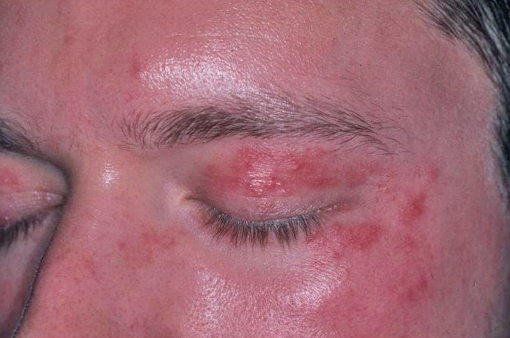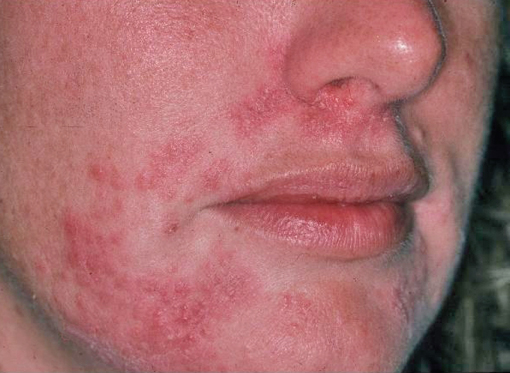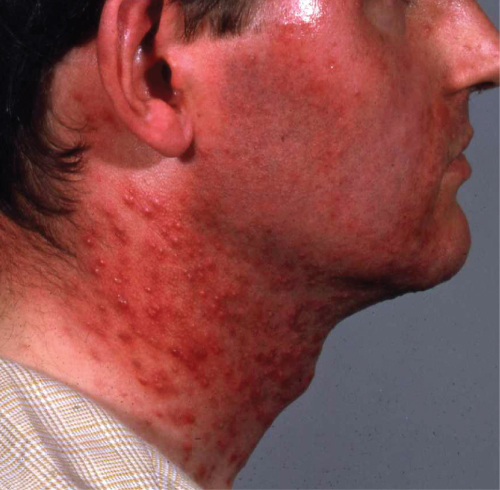Chapter 26 The treatment of skin disease has evolved dramatically over recent years. Historically, patients were admitted for intensive nursing with extemporaneously prepared combinations of topical steroids, tars, pastes and bandaging. Today however, there is a much greater emphasis on outpatient treatment. Quality control and cost issues have seen a reduction in the number of extemporaneous products available, and there have been exciting new developments in both topical and systemic treatment, particularly with the advent of monoclonal antibodies. The skin has the advantage of being readily amenable to treatment with topical therapy. Relatively high concentrations of medication can be applied to the skin safely, with good efficacy and comparatively few side effects. Several factors govern the choice of topical treatment, such as formulation, frequency of application, site and severity of skin disease and patient ability to apply local therapy. Complications tend to be local irritant or allergic reactions. The choice of topical treatment depends on the disease process, pharmaceutical properties of the drug, site of application and cosmesis. Emollients are important in the treatment of dry, scaly and inflammatory skin conditions as they help reduce transepidermal water loss from a damaged epidermal barrier. They soften dry skin by filling in the spaces left by desquamating keratinocytes. The constituents of an emollient or topical base have significant properties. Lipids, for example, cover the stratum corneum to prevent evaporation of water. White and yellow soft paraffin and liquid paraffin are extracted from crude oil. They are stable, inert hydrocarbons, which form the basis of most commercially available ointments and emollients. Emulsifying agents are used to stabilise emulsions, which are immiscible mixtures of aqueous and oily constituents, and penetration enhancers, such as urea and propylene glycol, may be used to increase penetration of an active component through the skin. Humectants are compounds with a high affinity for water, which are able to draw water into the stratum corneum and have useful emollient properties. The properties of various formulations of topical therapy are outlined in Table 26.1. Emollients can be applied liberally and regularly to all areas of dry skin. Table 26.1 Comparison of formulations for topical therapy. Bath emollients and soap substitutes are as important as regular emollients in the treatment of dry skin conditions. Soaps are detergents that irritate the skin by removing intercellular lipids and disrupt the barrier function of the stratum corneum, and should therefore be avoided. The development of topical corticosteroids in the 1950s revolutionised the treatment of skin disease. Since then, they have been used to treat a wide range of inflammatory dermatoses. The mechanism of action is complex. Steroid diffuses through the stratum corneum, cell membrane and into the cytoplasm of keratinocytes where it binds to the glucocorticoid receptor causing activation. The ligand-bound receptor enters the nuclear compartment and interacts with glucocorticoid response elements (GREs), resulting in the modulation of gene transcription. In addition, the ligand-bound receptor may also inhibit other transcription factors. The overall effect is to suppress inflammatory cytokines, inhibit T-cell activation and reduce cell proliferation. Topical corticosteroids are classified according to their potency, which is thought to be related to their glucocorticoid receptor affinity. Topical steroids are divided into four classes: This classification allows determination of the relative strength and therefore the potential side effects of therapy. Generally, the weakest steroid to effectively treat the skin condition should be chosen. Milder steroids should be used on the face and flexural sites. (Table 26.2 provides a detailed outline of topical steroids and their relative potencies). Table 26.2 Relative potency of topical corticosteroids. Topical corticosteroids should be applied ‘sparingly’. However, this is difficult to define and therefore the fingertip unit (FTU) system was devised. One FTU (a line of ointment from the tip of the finger to the first skin crease) is sufficient steroid to treat a hand-sized (palmar and dorsal surface) area of affected skin. In medical practice, it is common for patients to use insufficient amounts of topical steroids due to the fear of potential complications. Figure 26.1 Liberal application of a potent topical steroid resulting in striae formation. Figure 26.2 Perioral dermatitis caused by local application of topical steroids. Figure 26.3 Potent topical steroid induced atrophy and acne. Topical tacrolimus and pimecrolimus were originally developed for the treatment of eczema (in patients over the age of 2 years). These agents inhibit calcineurin (a calcium and calmodulin-dependent serine/threonine phosphatase) and suppress T-cell activation. Topical tacrolimus has also been used to treat alopecia areata, oral and genital lichen planus, pyoderma gangrenosum, cutaneous graft versus host disease and vitiligo with varying degrees of success. Pimecrolimus is less potent than topical tacrolimus and is used predominantly in the treatment of eczema in children as a steroid-sparing agent. A number of topical antimicrobial preparations are available, some of which are summarised in Table 26.3. Table 26.3 Topical antimicrobials used in the treatment of superficial infections. These are outlined in Table 26.4. Table 26.4 Miscellaneous preparations used in the treatment of psoriasis.
Formulary
OVERVIEW
Introduction
Topical therapy
Emollients
Formulation
Characteristics
Advantages
Disadvantages
Ointments
Oil-based. Provide occlusive film over skin and help retain water. Aid skin hydration and penetration of topical treatment
Tend not require preservatives as lack of water in preparation prevents microbial growth
Greasy and cosmetically less appealing to use
Creams
Emulsions containing water and oil. May be composed of oil in water or water in oil (oily creams). Aid skin hydration, but generally less effectively than ointments
Cosmetically acceptable
Contain preservatives, which may cause sensitisation
Lotions
Watery suspensions, often containing alcohol
Easily spread over a large area. Evaporation of water or alcohol has a drying, cooling effect
Cosmetically acceptable
Useful for hair-bearing areas, such as the scalp
Contain preservatives and therefore have sensitising potential. Alcohol may cause stinging
Gels
Semisolid emulsion in alcohol base. Useful for suspending insoluble drugs
Good absorbent properties
Tend to dry on skin
Useful for hair-bearing areas. Cosmetically acceptable especially for use on the face
Relatively high irritant and sensitising potential
Topical immunomodulatory treatments
Topical corticosteroids
Mode of action
Classification of topical steroids
Generic name
Proprietary name
Potency
1% hydrocortisone
Efcortelan®
Mild
1% hydrocortisone acetate and 1% fusidic acid
Fucidin H®
Mild
1% hydrocortisone, 1% nystatin 100 000 units/g and 3% oxytetracycline
Timodine®
Mild
Clobetasone butyrate 0.05%
Eumovate®
Moderate
Alclometasone dipropionate 0.05%
Modrasone®
Moderate
Betamethasone valerate 0.1%
Betnovate®
Potent
Mometasone furoate 0.1%
Elocon®
Potent
Diflucortolone valerate 0.1%
Nerisone®
Potent
Betamethasone dipropionate 0.05% and 3% salicylic acid
Diprosalic®
Potent
Betamethasone valerate 0.1% and fusidic acid 3%
Fucibet®
Potent
Clobetasol propionate 0.05%
Dermovate®
Super-potent
Clobetasol propionate 0.05%, neomycin sulphate 0.5% and nystatin 100 000 units/g
Dermovate NN®
Super-potent
Side effects of topical steroids



Calcineurin inhibitors
Topical antimicrobials
Preparation
Indications
Complications
Topical antibiotics
Fusidic acid
(Fucidin ointment®)
Staphylococcal infections
Resistance
Mupirocin
(Bactroban ointment®)
Gram positive and some gram negative organisms
Treatment of nasal staphylococcal carriage
Resistance
Silver sulfadiazine
(Flamazine®)
Pseudomonal infection and some prophylaxis against staphylococcal infection
Minimal absorption and renal impairment when applied to extensive burns
Topical antibiotics used in the treatment of acne
Tetracyclines
Erythromycin
Clindamycin
Acne
May be used in combination with keratolytics such as benzoyl peroxide
Resistance
May stain clothing yellow
Topical antifungals
Allylamines
Terbinafine cream
(Lamasil cream®)
Fungicidal against dermatophyte infections
Ineffective against dermatophyte infections of the nails and scalp
Imidazoles
Clotrimazole (Canesten®)
Econazole
Ketoconazole
Miconazole
Fungistatic
Active against Candida and Pityrosporum
Maybe used in combination with topical steroids
Used in the treatment of intertrigo, pityriasis versicolor and some dermatophyte infections
Concurrent use of topical steroid may mask infection
Amorolfine
(Loceryl lacquer®)
Fungistatic
Used in the treatment of onychomycosis
Some activity against Scytalidium
Synergistic activity with systemic antifungals
Poor cure rates in dermatophyte infections affecting the nail matrix when used as sole therapy
Topical anti-virals
Aciclovir cream
(Zovirax®)
Used to treat labial and genital herpes simplex
Needs to be applied as early as possible in the episode for maximum benefit
Anti-parasitic agents
Permethrin
5% cream used in the treatment of scabies and pubic lice. 1% rinse used to treat head lice
Require two treatments 1 week apart
Malathion
Used in the treatment of scabies, head lice and pubic lice
Alcoholic lotions can irritate skin and can exacerbate eczema
Resistance
Miscellaneous topical therapy used in the treatment of psoriasis
Stay updated, free articles. Join our Telegram channel

Full access? Get Clinical Tree








